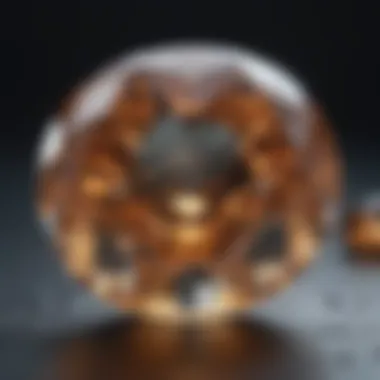Unveiling the Intricacies of Mineral Hardness Measurement in Gemology and Mineralogy


Overview of Gemstones and Minerals
Minerals and gemstones have played a significant role in human history and culture, with their use dating back to ancient times. The history of gemstones and minerals is deeply intertwined with various civilizations, symbolizing power, wealth, and spirituality. Gemstones like diamonds, rubies, and sapphires have been highly valued and sought after for centuries. Similarly, minerals such as quartz, amethyst, and topaz have held cultural significance in different societies worldwide. Understanding the history of gemstones and minerals provides valuable insights into the evolution of human fascination with these precious stones.
Gemstone Formation and Properties
The formation process of gemstones is a complex and intricate journey that spans millions of years. Gemstones are typically formed under specific geological conditions, involving a combination of heat, pressure, and various mineral interactions. The properties that define gemstones include their color, hardness, clarity, and luster. These characteristics not only determine the aesthetic appeal of a gemstone but also its value in the market. Gemstones are classified based on attributes like color, hardness (measured on the Mohs scale), and luster, which refers to the way light interacts with the stone's surface. Understanding these fundamental properties is essential for identifying and evaluating gemstones accurately.
Types of Gemstones
Gemstones are broadly categorized into two main groups: precious and semi-precious stones. Precious gemstones, like diamonds, rubies, emeralds, and sapphires, are typically rare and command high prices in the market. On the other hand, semi-precious gemstones encompass a wide range of stones, including amethyst, citrine, and turquoise, which are more abundantly found. Beyond these traditional categories, there are also exotic and rare gemstones that capture the imagination of collectors and enthusiasts due to their uniqueness and scarcity. These include stones like alexandrite, tanzanite, and paraiba tourmaline, which possess distinctive properties that set them apart from more common varieties.
Identifying and Evaluating Gemstones
The value of a gemstone is influenced by various factors, including its rarity, color intensity, clarity, and size. Gemologists employ sophisticated techniques for identifying gemstones through methods such as spectroscopy, microscopy, and magnification. By assessing a gemstone's quality based on criteria like cut, color, and carat weight, experts can determine its market worth and authenticity. Factors affecting gemstone value also include origin, treatment history, and overall craftsmanship, all of which play a vital role in evaluating the desirability and value of a gemstone. Proper gemstone identification and evaluation are crucial for ensuring fair trade practices and assisting consumers in making informed purchasing decisions.
Caring for Gemstones
To preserve the beauty and longevity of gemstones, it is essential to follow proper care guidelines. Cleaning and storing gemstones correctly help maintain their brilliance and prevent damage over time. Avoiding common mistakes in gemstone care, such as exposure to harsh chemicals or sudden temperature changes, can significantly impact the stone's appearance and durability. Additionally, certain gem types require specific preservation techniques, such as avoiding sunlight for opals or refraining from using ultrasonic cleaners for emeralds. By implementing these preservation tips, gemstone enthusiasts can ensure their precious stones retain their value and beauty for generations to come.
Introduction to Mineral Hardness
Mineral hardness, a fundamental characteristic in the realms of gemology and mineralogy, holds significant importance in understanding the physical properties of minerals. This section serves as a gateway to comprehending the intricacies of mineral hardness, shedding light on how it influences various aspects such as gemstone identification, mineral classification, and industrial applications. Delving into the essence of mineral hardness unveils a world where the resilience and durability of minerals come to the forefront, shaping not only scientific fields but also practical industries.
Defining Mineral Hardness
Mohs Scale of Mineral Hardness
The Mohs Scale of Mineral Hardness stands as a cornerstone in the assessment of mineral hardness, offering a practical and intuitive way to compare the scratch resistance of different minerals. Developed by Friedrich Mohs in 1812, this scale assigns a hardness value from 1 to 10 to minerals based on their ability to scratch or be scratched by another material. Its simplicity and effectiveness make it a valuable tool in mineral identification, geology, and materials science. While the Mohs Scale simplifies the concept of hardness, its limitation lies in the qualitative nature of the rankings, lacking precise numerical values.
Importance in Geology


The importance of mineral hardness in geology lies in its role as a fundamental property used to differentiate and identify minerals in their natural environments. Geologists rely on hardness as a key characteristic when conducting fieldwork, as it aids in mineral identification and classification. Understanding the hardness of minerals assists geologists in interpreting geological processes, identifying mineral resources, and assessing the durability of materials used in construction. Despite its significance, hardness alone cannot determine the overall suitability of a mineral for specific industrial applications due to the complexity of material properties.
Historical Perspective
Origins of Hardness Scale
The origin of hardness scales can be traced back to ancient civilizations that utilized minerals for various purposes. However, the modern concept of a standardized hardness scale emerged with Friedrich Mohs' development of the Mohs Scale. This pioneering work revolutionized the field of mineralogy by providing a practical method to compare mineral hardness systematically. By establishing a scale based on the relative scratch resistance of minerals, Mohs laid the foundation for future advancements in material science and geology, cementing the importance of hardness as a fundamental property for mineral identification and characterization.
Key Concepts
Scratch Test
The scratch test is a fundamental technique used to determine the hardness of minerals by assessing their resistance to abrasion. By scratching a mineral surface with a reference material of known hardness, such as a fingernail or a copper penny, geologists can estimate the relative hardness of the mineral based on the resulting scratch. This simple yet effective method provides valuable insights into the physical properties of minerals, aiding in their identification and classification.
Resistance to Abrasion
Resistance to abrasion refers to a mineral's ability to withstand wear and erosion when exposed to external forces. Minerals with high abrasion resistance are prized for their durability and longevity in various applications, ranging from construction materials to gemstones. Understanding the factors that contribute to a mineral's resistance to abrasion, such as crystal structure and chemical composition, is essential in selecting materials for specific industrial uses and evaluating their performance in demanding conditions.
Significance in Gemology
The Significance in Gemology section of this article explores the crucial role that mineral hardness plays in the world of gemstones. Gemology, as a field, heavily relies on understanding the hardness of minerals to identify and classify gemstones accurately. The ability to determine the hardness of gemstones is essential in distinguishing between different types of gems and assessing their durability and suitability for various jewelry-making processes. Through the Significance in Gemology segment, readers will delve into the intricate relationship between mineral hardness and gemstone characteristics, shedding light on the practical aspects of gemstone identification.
Gemstone Identification
Gemstone Testing Methods
Gemstone Testing Methods are fundamental processes utilized in the gemological world to assess the authenticity and quality of gemstones. These methods involve a series of tests and examinations that evaluate the physical and chemical properties of gemstones to determine their identity accurately. Gemstone Testing Methods contribute significantly to the field of gemstone identification by providing gemologists with essential tools to differentiate between natural and synthetic gemstones, detect treatments and enhancements, and classify gems based on their inherent characteristics.
In this article, the emphasis on Gemstone Testing Methods underscores their pivotal role in gemology. Their reliability and precision in evaluating gemstone properties make them a popular choice among gemologists worldwide. The unique feature of Gemstone Testing Methods lies in their ability to offer conclusive results, guiding gemstone enthusiasts, collectors, and jewelry designers in making informed decisions based on scientific analysis. While Gemstone Testing Methods offer invaluable insights, they also present limitations, such as the need for specialized equipment and expertise to conduct tests accurately.
Impact on Jewelry Making


The Impact on Jewelry Making section highlights how gemstone hardness influences the craft of jewelry creation. The hardness of gemstones directly impacts their usability in jewelry making, as softer gemstones are susceptible to damage from everyday wear and tear. Understanding the hardness of gemstones is crucial for jewelry designers to select appropriate stones that can withstand the rigors of being set in various pieces.
This article delves into the significance of gemstone hardness in the realm of jewelry making, emphasizing its importance in ensuring the longevity and durability of jewelry pieces. The key characteristic of considering gemstone hardness in jewelry making is to guarantee the integrity of the final product, offering consumers jewelry that not only dazzles with beauty but also endures the test of time. While the impact of gemstone hardness on jewelry making is essential, designers must weigh the advantages of using harder gemstones for longevity against the potential challenges of working with these tougher materials.
Diamond Hardness
Diamond as the Hardest Mineral
Among all minerals, diamond reigns as the hardest natural substance known to humankind. Its exceptional hardness on the Mohs Scale positions diamond in a class of its own, making it a coveted gemstone for various applications. The hardness of diamond contributes significantly to its durability and resilience, qualities that have elevated it to the status of a symbol of eternal love and luxury.
This segment focuses on the unparalleled hardness of diamond and its implications for gemology. The unique feature of diamond hardness lies in its unmatched resistance to scratching and abrasion, ensuring that diamond remains pristine and unblemished over time. While the hardness of diamond offers unparalleled advantages in jewelry and industrial applications, it also presents challenges in terms of cutting and shaping due to its extreme toughness and precision required to work with this precious gemstone.
Practical Applications
Choosing Gemstones for Durability
When considering gemstones for various applications, durability emerges as a critical factor in the decision-making process. Choosing Gemstones for Durability section elucidates the importance of selecting gemstones based on their hardness and resilience to ensure longevity and wearability. Jewelry designers and consumers alike weigh the durability of gemstones to guarantee that their pieces retain their beauty and integrity throughout use.
This article delves into the practical applications of selecting gemstones for durability, emphasizing the need to balance aesthetic appeal with functional longevity. The key characteristic of choosing gemstones for durability lies in understanding the hardness scale and selecting gems that can withstand daily wear without succumbing to damage. While durable gemstones offer lasting beauty and investment value, they may pose challenges in terms of availability and cost due to their rarity and sought-after properties.
Measurement Scales
The measurement scales play a crucial role in the realm of mineral hardness exploration, serving as the quantitative foundation for assessing the hardness of minerals. Understanding these scales offers gemstone enthusiasts, collectors, jewelry designers, and geology enthusiasts indispensable tools to differentiate between various minerals based on their hardness. By comprehending the specific elements and insights provided by these scales, individuals can make informed decisions regarding gemstone identification, jewelry making, and mineral classification. The benefits of delving into measurement scales include refining one's skill in identifying minerals, selecting durable gemstones for jewelry, and categorizing minerals based on hardness levels. Additionally, considerations about measurement scales encompass the need for precision in assessment, the accuracy of hardness measurements, and the practical applications of scale knowledge in research and industry practices.
Mohs Scale
Overview of Mohs Scale
The Mohs scale, a fundamental tool in mineralogy, offers a sequential ranking of minerals based on their relative hardness compared to one another. This scale, developed by Friedrich Mohs in 1812, simplifies the determination of mineral hardness by defining a mineral's hardness based on its ability to scratch or be scratched by other minerals. The key characteristic of the Mohs scale lies in its simplicity and ease of use, making it a popular choice for mineralogists and geologists alike. By utilizing a set of common minerals as reference points for hardness levels, the Mohs scale provides a practical and accessible framework for assessing mineral hardness. However, limitations of the Mohs scale include its subjective nature and inherent lack of quantitative hardness values, which can pose challenges in precise hardness comparisons.
Characteristics of Minerals


Understanding the characteristics of minerals within the context of hardness is essential for discerning their relative hardness levels and properties. Key characteristics to consider include cleavage, color, transparency, and crystal structure, which can influence a mineral's overall hardness. By examining these unique features, individuals can identify patterns in mineral properties that correlate with hardness levels. This knowledge enhances the ability to differentiate between minerals of varying hardness and aids in accurate mineral classification and identification. While the characteristics of minerals provide valuable insights into their hardness, they may also introduce complexities in hardness assessments due to variations in mineral composition and structure.
Other Hardness Scales
Brinell Scale
The Brinell scale, a prominent hardness testing method, measures the hardness of materials through the indentation made by a hard ball or carbide ball. This scale's key characteristic lies in its ability to assess the hardness of metallic materials, providing essential data for industrial applications and material testing. The Brinell scale's unique feature includes its capacity to offer hardness measurements across a wide range of materials, from soft metals to hardened steels. While advantageous for evaluating the hardness of metals, the Brinell scale may present challenges in testing brittle or thin materials, limiting its applicability in certain contexts.
Vickers Scale
In contrast, the Vickers scale introduces a microscopic indentation test using a pyramid-shaped diamond indenter, enabling the measurement of hardness across various materials with precision. The key characteristic of the Vickers scale is its versatility in assessing the hardness of metals, ceramics, and composites, offering a comprehensive approach to hardness testing. By utilizing standardized testing procedures and indentation techniques, the Vickers scale ensures accurate and reproducible hardness measurements, enhancing its reliability in material analysis. However, the Vickers scale's unique feature of utilizing a diamond indenter may lead to higher testing costs and the potential for surface damage on softer materials.
Comparison and Usage
Considering the pros and cons of different hardness scales is vital for selecting the most appropriate scale for specific applications in mineralogy, gemology, and material testing. Each scale, whether Mohs, Brinell, or Vickers, offers distinct advantages and limitations that influence its suitability for hardness assessment. Pros of different scales include Mohs' simplicity, Brinell's applicability to metals, and Vickers' precision across diverse materials. Conversely, cons such as Mohs' subjectivity, Brinell's limitations on brittle materials, and Vickers' potential for surface damage illustrate the considerations in scale selection. Understanding the unique features and characteristics of each scale enables informed decision-making when choosing the most effective hardness scale for various testing scenarios.
Implications in Mineralogy
In the realm of mineralogy, understanding the implications of mineral hardness plays a vital role in various aspects of geological and industrial applications. Mineral hardness serves as a fundamental criterion for mineral classification and identification. By categorizing minerals based on their hardness, researchers and geologists can better understand their properties, formation processes, and potential uses. The ability to assess hardness also facilitates the selection of suitable tools and equipment for mining operations, enhancing efficiency and safety.
Mineral Classification
Hardness-Based Categorization
Hardness-based categorization is a cornerstone of mineral classification, providing insights into the physical properties and durability of different minerals. This method categorizes minerals based on their resistance to scratching and abrasion, offering a systematic approach to identifying and distinguishing between various mineral species. The key characteristic of hardness-based categorization lies in its quantitative nature, allowing for precise comparisons and assessments across different mineral samples. This approach is particularly beneficial in mineralogy as it aids in the accurate identification and differentiation of minerals with similar appearances.
Impact on Mining Operations
The impact of mineral hardness on mining operations is profound, influencing the choice of extraction methods, machinery selection, and overall operational efficiency. Minerals with high hardness levels may require specialized equipment and tools to facilitate extraction processes while minimizing equipment wear and operational costs. Understanding the hardness of minerals present in a mining site helps in devising optimal strategies for resource extraction, ensuring sustainability and resource utilization.
Tool Manufacturing
The significance of mineral hardness extends to tool manufacturing, where the durability and abrasion resistance of tools are crucial for efficient and effective use in various industries. Tools crafted from materials with appropriate hardness levels exhibit longevity and reliability, reducing maintenance costs and enhancing productivity. The unique feature of tool manufacturing lies in the precision required to match tool hardness with the minerals to be processed, ensuring optimal performance and extended tool lifespan. While hardness-based tool manufacturing offers enhanced durability, it may pose challenges in terms of tool customization and adaptability.
Research and Development
Materials Science Applications
Materials science applications of mineral hardness encompass a wide range of industries, from construction to electronics, where the mechanical properties of materials are of utmost importance. By utilizing the hardness characteristics of minerals, researchers can develop innovative materials with enhanced durability, strength, and versatility for various applications. The key characteristic of materials science applications lies in the ability to tailor material properties based on hardness requirements, enabling the creation of customized solutions for specific industry needs. While materials science applications offer significant advantages in material design and optimization, challenges may arise in balancing hardness with other desired properties such as flexibility and conductivity.







